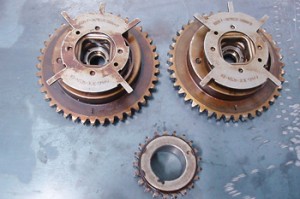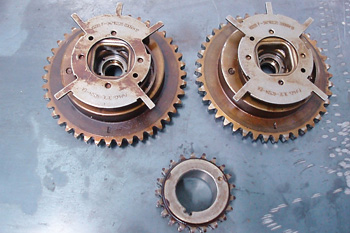There’s no doubt that engine specialists will begin seeing more variable valve timing (VVT) designed engines in their shops, as the generation of vehicles equipped with this technology begins to make its way into the service industry.

In fact, the current versions of VVT were popularly introduced into domestic production about 10 years ago.
Operating Principles
The theory behind variable valve timing is simple. Imagine a column of air speeding through a two-inch pipe at 250 feet per second. Suddenly, the air flow is blocked off by a valve at the end of the pipe.
The kinetic energy of the air keeps it moving until a compression wave begins to develop at the valve. The optimum time to open the valve and achieve the greatest air flow is when this compression wave reaches its peak. In contrast, the best time to open the exhaust valve is when a vacuum wave develops at the valve.
Variable valve timing takes advantage of these pressure and vacuum waves to achieve a greater air flow through a given size of engine. Advancing valve timing increases low-speed engine torque while retarding valve timing increases high-speed torque. The Powertrain Control Module (PCM) determines the valve timing position through data supplied by the camshaft position sensors or by valve timing sensors. Be aware of this terminology because some vehicles can use both types of sensors on a single engine.
Parts Nomenclature
The part that actually controls the camshaft position (and the valve timing event) is called a “phaser.” VVT Phaser design includes piston and vane-type configurations. In either case, the phaser uses engine oil pressure to push the piston or rotating vanes against a strong spring. With the vane-type phaser, a clock spring returns valve timing to a “default” position during engine start-up or if the VVT system fails. Another part, called a valve timing solenoid, meters engine oil pressure into the phaser.
The VVT solenoid is supplied key-on voltage and the PCM momentarily grounds the circuit to meter oil pressure into the phaser until the valve timing reaches the desired value. The valve timing solenoid also includes a very fine-mesh screen to prevent sludge and debris from entering the mechanism.
Lubrication Issues
Since correct lubrication is critical to the operation of the VVT phasers and solenoids, it’s doubly important that the correct viscosity of oil is used in a VVT engine.
Because VVT designs use a metered oil orifice to adjust valve timing, an oil with a higher than specified viscosity can cause false VVT trouble codes to be stored in the PCM. In addition, the oil must have the correct additive package to keep the engine’s oil passages, phasers, and VVT solenoid screens clean.














